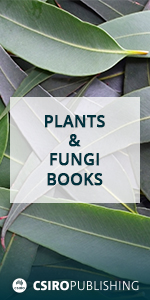
Functional Plant Biology
Volume 45 Number 10 2018
FP17323Diversity in structure and forms of carbon assimilation in photosynthetic organs in Cleome (Cleomaceae)
There is great interest in plants that capture CO2 from the atmosphere and concentrate it in leaves to support photosynthesis. The present study shows the diversity in expression and function of this and other forms of photosynthesis in cotyledons, leaves, stems, petioles and pods during the life cycle of Cleome species. Further investigation into the genetic regulation of development of these forms within and between species is needed.
FP18008Fructan dynamics and antioxidant capacity of 4-day-old seedlings of wheat (Triticum aestivum) cultivars during drought stress and recovery
Fructans have a crucial role in the maintenance of plant membranes under stress conditions. With the aid of fructans, 4-day-old wheat seedlings tolerate severe drought stress and successfully recover after re-watering. OH• radicals scavenging capacity of fructans is governed both by their structure and function.
FP17309Utilisation of stored lipids during germination in dimorphic seeds of euhalophyte Suaeda salsa
Suaeda salsa is an economically important euhalophyte because its seed oil is edible and rich in unsaturated fatty acids. Compared with black seeds, certain enzymes in the glyoxylate cycle in brown seeds play a more important role in the utilisation of stored lipids to provide soluble sugar during their rapid seed germination. This work provides new insights to aid understanding of the adaptation of dimorphic seeds to harsh saline environments.
FP17322High-throughput chlorophyll fluorescence screening of Setaria viridis for mutants with altered CO2 compensation points
Engineering rice to perform a more efficient form of photosynthesis could increase yields by roughly 50%. Identifying the genes controlling this supercharged C4 photosynthetic process is a significant challenge. Using a rapid and efficient screening method we identify a large number of mutant plants that can be used to reverse engineer and understand this process.
FP17299An insight into the downstream analysis of RB gene in F1 RB potato lines imparting field resistance to late blight
The mechanism of the RB gene mediates broad-spectrum resistance to develop strategies for breeding durable potato late blight resistance. Our results suggest that the effective deployment of the RB gene in the host background contributes immensely to the scientific understanding of R gene interaction with host protein complexes to regulate the defence system in plants. Further, it also corroborates the fact that efficacy of R gene is not solely dependent on its presence in the variety but largely depends on the stability and functionality of the gene.
FP17269Stimulation of cyclic electron flow around PSI as a response to the combined stress of high light and high temperature in grape leaves
Cyclic electron flow (CEF) has been identified as an important mechanism for photoprotection. We investigated the potential role of CEF in heated grape leaves under high light. Our findings provide insights into understanding the importance of CEF in protecting photosystems and will help to reveal the strategy of plants in adapting to changing environments.
FP17326A study of transcriptome in leaf rust infected bread wheat involving seedling resistance gene Lr28
Wheat is an important staple food crop worldwide, but leaf rust disease in this crop causes >50% yield losses. A transcriptomic approach using RNA-Seq in a pair of near-isogenic lines (NILs) resolved differential expression of hundreds of genes in presence/absence of Lr28. This will help build a better understanding of host–pathogen interaction (HPI) involving leaf rust in bread wheat.
FP18011Exogenous fragmented DNA acts as a damage-associated molecular pattern (DAMP) inducing changes in CpG DNA methylation and defence-related responses in Lactuca sativa
Self-DNA (sDNA) seems to act as a DAMP in lettuce, although only genetic and plant phenotype studies have been reported. This work aimed to explore the possibility that epigenetic and biochemical effects of sDNA as a DAMP in lettuce can be detected, based on gene expression levels reported elsewhere. The main results of our work displayed, for the first time, the epigenetic and biochemical effects of sDNA as a DAMP in addition to molecular and phenotypical effects.
FP18009Evaluation of salt-tolerant germplasm and screening of the salt-tolerance traits of sweet sorghum in the germination stage
Germination is very important for the yield of all crops and is severely affected by salinity. Little has been known about evaluating salt tolerance or screening the reliable evaluation traits for sweet sorghum. The salt tolerance of 300 sweet sorghum germplasms was evaluated, and the germination index under 200 mM NaCl showed the highest correlation with salt tolerance. These results can be used for effective evaluation of salt tolerance in sweet sorghum during germination.




